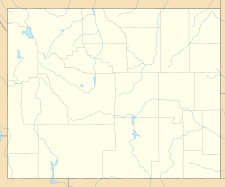East Torrey Glacier facts for kids
Quick facts for kids East Torrey Glacier |
|
|---|---|
| Type | Mountain glacier |
| Coordinates | 43°19′00″N 109°40′20″W / 43.31667°N 109.67222°W |
| Area | 500 acres (200 ha) |
| Length | .70 miles (1.13 km) |
| Width | 1.15 mi (1.85 km) |
| Terminus | moraines/proglacial lake |
| Status | retreating |
The East Torrey Glacier is a large ice mass found in the Shoshone National Forest in Wyoming, a state in the USA. It sits on the east side of the Continental Divide, which is like a giant mountain ridge that separates rivers flowing to the Pacific Ocean from those flowing to the Atlantic or Arctic oceans. This glacier is located in the northern part of the Wind River Range, a tall mountain chain.
The East Torrey Glacier is part of the biggest group of glaciers in the American Rocky Mountains. It is very close to another glacier called Continental Glacier and north of a mountain named Downs Mountain. This glacier has three separate parts, or "lobes," and has moved back quite a bit, leaving two proglacial lakes behind. These lakes form when a glacier melts and the water collects in front of it.
Contents
What is a Glacier?
A glacier is a huge body of ice that moves very slowly over land. Think of it like a very slow-moving river made of ice! Glaciers form in places where snow falls but doesn't completely melt during the summer. Over many years, layers of snow pile up, get compressed, and turn into dense ice.
How Glaciers Form
Snowflakes fall and build up year after year. As new snow falls, it presses down on the old snow beneath it. This pressure squeezes the air out of the snow, making it denser and turning it into ice. When the ice becomes thick enough, gravity starts to pull it downhill, causing the glacier to flow.
Types of Glaciers
There are different kinds of glaciers. The East Torrey Glacier is a mountain glacier, also known as an alpine glacier. These glaciers form in high mountain valleys and flow down the slopes. Other types include ice sheets, which are much larger and cover entire continents, like in Greenland or Antarctica.
Where is East Torrey Glacier Located?
The East Torrey Glacier is found in a wild and beautiful area called the Fitzpatrick Wilderness. This wilderness area is part of the larger Shoshone National Forest. The forest is located in Fremont County, Wyoming.
Geographic Features Nearby
- Continental Divide: This is a high ridge in the Rocky Mountains. Water on one side flows east, and water on the other side flows west. The East Torrey Glacier is on the eastern side.
- Wind River Range: This is a long mountain range in Wyoming, known for its tall peaks and many glaciers.
- Proglacial Lakes: These are lakes that form directly in front of a melting glacier. The East Torrey Glacier has left two of these lakes behind as it has retreated.
How Big is East Torrey Glacier?
The East Torrey Glacier is quite large, even though it is getting smaller. It covers an area of about 500 acres. To give you an idea, 500 acres is roughly the size of 375 football fields!
Measurements of the Glacier
- Area: About 500 acres.
- Length: It stretches for about 0.70 miles (or 1.13 kilometers).
- Width: At its widest point, it measures about 1.15 miles (or 1.85 kilometers).
What is Happening to the Glacier?
The East Torrey Glacier is currently retreating. This means it is melting faster than new snow and ice can build up. As a result, the glacier is getting smaller and its front edge is moving backward.
Signs of Retreat
When a glacier retreats, it leaves behind certain features. The East Torrey Glacier has left behind two proglacial lakes. It has also moved well above its old moraines. Moraines are piles of rocks and dirt that a glacier pushes or carries along its edges and front. They act like natural dams, sometimes holding back the water that forms proglacial lakes.
Why Glaciers Retreat
Glaciers retreat for many reasons, but a main one is a change in climate. If temperatures get warmer or there is less snowfall, glaciers will melt faster than they can grow. Scientists study glaciers like East Torrey Glacier to understand how our planet's climate is changing.
Why Glaciers are Important
Glaciers are very important for our planet and for people. They store a lot of fresh water, acting like giant frozen reservoirs.
Water Supply
Many communities around the world rely on meltwater from glaciers for drinking water, farming, and making electricity. As glaciers shrink, this water supply can become less reliable.
Ecosystems
Glaciers also create unique environments for plants and animals. The cold meltwater feeds streams and rivers, supporting different kinds of fish and other wildlife.
Climate Indicators
Because glaciers are so sensitive to temperature changes, they are like natural thermometers for the Earth. By studying how glaciers grow and shrink, scientists can learn a lot about climate change and its effects.


